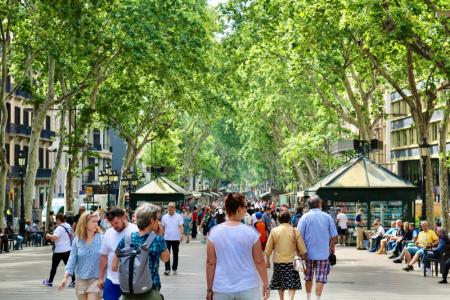
Julieta Lahud, Programme Officer in the Nature-based Solutions team at the UN Environment Programme World Conservation Monitoring Centre (UNEP-WCMC), shares her key takeaways from representing NetworkNature at the recent Conexus conference in Barcelona
Cities are spaces of immense possibility, but rapid urbanisation results in the concentration of many environmental and social challenges. Cities are often more vulnerable to flooding, air pollution and biodiversity loss – problems that interact with the pressures of congestion, affordability and inequality faced by residents and intersect with them.
Many city leaders now recognise that protecting, sustainably managing and restoring ecosystems can address societal challenges at the same time as helping nature. In Europe for example, mayors and city representatives are coordinating their efforts under the Green City Accord and the EU Urban Nature Platform. Many cities are exploring how urban forests, green roofs and walls, and meadows and hedges can help tackle the challenges created by rapid urbanisation and contribute to global climate and biodiversity goals. However, gaps remain in the tools and knowledge needed for decision-makers to deploy these actions, referred to as Nature-based Solutions (NbS), in urban spaces.
In May, I joined a meeting of technical experts and urban planners in Barcelona to discuss how to increase the adoption of NbS in urban planning for people and nature. The conference was hosted by Conexus, an EU Horizon 2020 funded project that seeks to bring together Latin American and European partners to strengthen international cooperation on urban NbS and ecosystem restoration. Over three days, we explored the barriers to greater uptake of NbS in urban spaces.
- A lack of finance is holding NbS back
Discussions among panellists and attendees highlighted that a lack of finance is one of the main challenges to mainstreaming nature into city planning. Challenges mentioned included: national funding for NbS is mostly public, international funding allocated to infrastructure in Latin America and the Caribbean is insufficient, and funding for infrastructure that includes NbS is particularly limited. Investment in NbS is seen as high-risk by many investors, in part due to a perceived lack of robust cost-benefit methodologies, concerns about how NbS fit into regulatory and institutional frameworks, and the time it can take for the benefits of some NbS to materialise.
- Decision makers’ understanding of the value of NbS lags behind other solutions
I heard repeatedly about the need to develop valuation tools to quantify the benefits that nature provides to us - also known as ecosystem services. These benefits are vital but can be left out of decision-making because they aren’t considered to be ‘easily’ quantified. At the Conexus conference, an increasing number of tools were presented to support cost-benefit analysis (for both economic and non-economic values), including modelling and other valuation methods. Experience in using these tools is also growing. Once the values of ecosystem services in cities are assessed using such tools, their importance can be better understood. This can help make the business case for NbS approaches as actions that protect, sustainably manage and restore the ecosystems that provide such services while also providing a range of other benefits for people and nature.
- More evidence of NbS benefits for biodiversity is needed
While NbS benefits and co-benefits are widely recognised, there was a notable sense at the conference that methodologies and concrete evidence showing how NbS enhances biodiversity are limited. More tools and comprehensive data are needed to effectively assess this, and to feed into the process to value the important contribution that NbS make to urban nature.
What NetworkNature is doing to address these challenges
NetworkNature provides resources and capacity-building tools to address some of the key challenges to integrating NbS into city planning. Through initiatives like UrbanbyNature, NetworkNature aims to embed NbS in local and regional governments’ planning and policy processes. By helping to collate and disseminate information on the multiple benefits of NbS, NetworkNature helps address the knowledge gaps to support NbS uptake, including on NbS valuation.
As a partner in NetworkNature, UNEP-WCMC brings a wealth of relevant experience, including on urban ecosystem accounting and as a collaborator in the IUCN Urban Nature Indexes (UNI) - a tool to enable cities to assess their ecological performance. On behalf of NetworkNature, I conducted a session at Conexus on “Accounting for Nature in Planning: Approaches for Integrating Nature-based Solutions in Cities”. I shared how NetworkNature’s work and urban ecosystem accounting tools can bridge the gap in knowledge and tools for effective decision-making for urban planners. For example, UNEP-WCMC’s work under NetworkNature’s Sustainable Finance, Investment, and Just Transition theme includes exploring what the current financing landscape is for NbS (including in cities), how different approaches can help compare NbS with other solutions, and what metrics can be used to do this.
To hear more about our work with NetworkNature to integrate NbS in cities, join us at the NetworkNature Annual Event in Brussels in September.